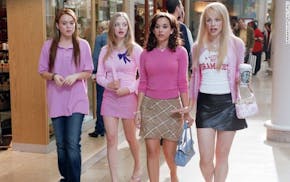Childbirth is a beautiful thing — bringing life into the world, and all that — but it's also scary as heck and pretty gross. Combine that with the dark arts, as Grady Hendrix does in "Witchcraft for Wayward Girls," and you've got the makings of a fantastic body horror novel.
Actually, it's so much more than that. Hendrix is a wizard at mixing together tropes of terror in thought-provoking ways — with no small amount of humor thrown in — that always exceed the sum of their parts.
2014's "Horrorstör," for instance, takes an Ikea clone called ORSK and a handful of employees who spend the night in the furniture superstore, inconveniently built on the site of a notorious prison, and spins it into a brutal haunting that has a lot to say about menial labor and what it does to workers.
In 2016's "My Best Friend's Exorcism," Hendrix combines 1980s satanic panic with friendships among teen girls, possession and the best ever casting-out-of-a-demon scene that includes the lyrics of the Go-Go's "We Got the Beat."
And 2020's "The Southern Book Club's Guide to Slaying Vampires" follows a housewife as she discovers her worth when she goes toe-to-toe with a bloodsucker only she has been able to suss out in her Charleston neighborhood. Not to mention the haunted puppets of 2022's "How to Sell a Haunted House," which underscore the horror created by a family's inability to communicate.
There are even more examples, but you get the idea: Hendrix is interested in scaring the pants off readers but also digging a little deeper into what the scares — and the pants, for that matter — might mean. That he often does so from the perspective of female protagonists is even more intriguing.
In "Witchcraft for Wayward Girls," Hendrix leans into the trauma of being an unwed teen mother in 1970 — and 15-year-old Neva is living it. Her family is horrified, as any "respectable" family would have been at the time, and as a result Neva's dad takes her on a long drive across state lines:
"'What's happening, Dad?' she asked, and she couldn't help it, she was so scared. 'Why are we in Florida?'
"He shifted from side to side in his seat, adjusted his hands on the wheel, then addressed the windshield like it really needed to understand this was for its own good."
He takes Neva to Wellwood House, a place for girls in her condition, where she will stay until the baby is born and a deserving couple with means will adopt him or her. Afterward everything will go back just the way it was before, as if nothing ever happened. But things are never that easy, and as you've probably guessed, won't be for Neva.
Already feeling powerless over her situation, Neva is made to feel even more so when she is stripped of her name upon arrival, allegedly to protect her and the other girls' privacy: "I think of you as my garden of girls," Miss Wellwood, who runs the house, tells her. "And I have been called to protect you during this time of your flowering. While you are here you will be called … Fern."
Just when Fern is nearing her lowest point, the bookmobile bounces up to the isolated Wellwood House, bringing Miss Parcae into her life and a book the librarian recommends, "How to Be a Groovy Witch." (It's 1970, remember?) For the first time, Fern begins to feel that control might be within her grasp after all, but at what cost?
Hendrix makes splendid use of the history and symbology of witches to get at the hypocrisy of how unwed mothers have been treated. Whether embracing that history will turn out for good or ill remains to be seen — and then you'll need to figure out for yourself what "good" and "ill" even mean in the context of this girl's worst nightmare.
Witchcraft for Wayward Girls
By: Grady Hendrix.
Publisher: Berkley, 482 pages, $30.

Review: These heroic 'Secret Warriors' helped America win a war even as they were treated as enemies
Review: 'A Man of Two Faces' author's essays are about being an 'other'

Review: Whodunit in 'Perspective(s)'? Would you believe Michelangelo?

Justin: How 'Mean Girls' became the 'fetchiest' film of the 21st century

